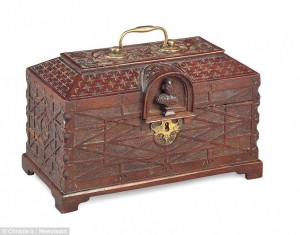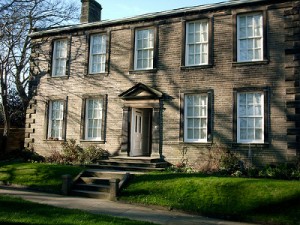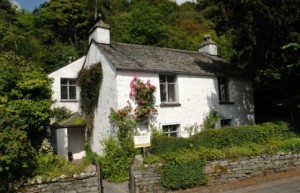 In the past week there have been many stories in the media about Shakespeare tourism and its history. Early in the week a carved commemorative Tea Caddy made in 1759 of mulberry wood from the tree reputed to have been planted by Shakespeare, and featuring a bust of the poet, sold for £13,750, well above the estimate of £5-10K. It’s a reminder of how long Shakespeare has been celebrated in his own town as well as the healthy market in notable and historic memorabilia.
In the past week there have been many stories in the media about Shakespeare tourism and its history. Early in the week a carved commemorative Tea Caddy made in 1759 of mulberry wood from the tree reputed to have been planted by Shakespeare, and featuring a bust of the poet, sold for £13,750, well above the estimate of £5-10K. It’s a reminder of how long Shakespeare has been celebrated in his own town as well as the healthy market in notable and historic memorabilia.
The Shakespeare Birthplace Light Spectacular was launched on Thursday, a light show which is going to be run at half-hourly intervals after dusk until just before Christmas, consisting of projected moving images, a recorded sound track and live performances of speeches from Shakespeare. Click here for details. It’s not the first time that the Birthplace has been used as a backdrop for images. Right back in 1769 David Garrick hung a transparency from the window of the Birthroom showing the sun breaking through the clouds accompanied by a suitable quotation suggesting that Shakespeare’s works cast their own light on the world. Illustrations created at the time show the Birthplace in a dilapidated state, and Garrick’s transparency and planned parade of Shakespearean characters (abandoned because of the weather), did at least show the importance which he and the Jubilee-goers gave to the Birthplace and perhaps the hope that it would be improved.
Here’s the Youtube video of the premiere.
On Friday, at the Shakespeare Centre next to the Birthplace the LitHouses group held its annual conference. This group was formed 10 years ago “dedicated to excellence in the presentation of the great homes and museums of English Literature.” The first meeting was also held in Stratford, which group leader Henry Cobbold, from Edward Bulwer Lytton’s house, Knebworth, described as “the spiritual home of English Literature”. Support and networking has always been an important part of the group’s meetings: many of the houses taking part receive relatively few visitors but are run by passionately committed people. Around 25 houses were represented at the meeting, from the famous houses lived in by Jane Austen and the Brontes to the much less well-known John Bunyan and William Cowper. If you would like to know more about any of the houses, the links are on the website.
The conference was subtitled “Anniversary Assessment of Achievements and Aspirations. One of the aspirations shared by all the participants was the need to maintain visitor numbers, so publicity and marketing was an important theme for the day. In her introduction Viscountess Cobham, the Chairman of VisitEngland commented on the extent to which England is epitomised by its literature, and how “literary figures are global exports”.
Literary houses and their collections may be cultural gems, but they present special challenges. One participant asked the question “How do you bring your writers to your visitors?” And a comment, read out during the meeting, highlighted the difficulty of representing the work of a writer within a building, since the work for which they are famous “transcends the place, the home and the collection”. It’s asking a lot for a building and a collection to be able to represent the essence of the writer especially when physical objects, may have little to do with the work itself. In Shakespeare’s case it’s particularly tricky as all the objects that might have had an association with him had been sold off by unscrupulous owners well before the SBT was founded in 1847. As shown by the mulberry wood box the trade in souvenirs was already in full swing in the 1750s and the first town plan, from 1759, marked the house in which Shakespeare was born showing that it was already a tourist destination.
The ways in which houses bring their writers to their visitors have become very imaginative. Poetry readings, performances of extracts from plays, and meetings such as book clubs have now become almost routine. During the Conference’s lunch break we were treated to another way in which Shakespeare’s plays are brought to a different audience. It was Takeover Day, and two local year 6 classes took over the running of the Shakespeare Birthplace Trust, including guiding in Shakespeare’s Birthplace, handling documents in the SCLA and selling tickets. They also wrote and performed their own version of Macbeth with only a couple of days preparation and the help of the Shakespeare Aloud actors. I particularly liked Lady Macbeth’s line, spoken after Macbeth had expressed his doubts about killing Duncan: “Don’t be so pathetic. Just do it!”, that showed a real understanding of the speech even if it raised a laugh rarely heard in the original.
The performance, coming in the middle of a day in which there had been much talk about visitor numbers, marketing and social media, was a reminder of the reason why literary houses exist. Some people are making their own secular pilgrimage, some are merely there out of interest, but all depend on the continuing appeal of the books that were produced by the extraordinary imagination of the human mind.
I subscribe to the weekly edition of Brain Pickings, always a thought-provoking digest of material. This week’s post includes an article about the writer Anne Lamott and her book Bird by Bird: Some Instructions on Writing and Life. She defines very simply the job of the writer: “Writing is about learning to pay attention and to communicate what is going on” and quotes Susan Sontag’s similar thought, “That’s what a writer does – a writer pays attention to the world”. The most successful authors seem to share the experiences and emotions of their readers, and those who run the houses have the difficult job of developing that connection and making new converts for their writer. It’s a difficult job, but the commitment of those at Friday’s meeting to the promotion of “their” author was clear.



